To get a reliable and durable natural wood staircase, it must be assembled from quality elements. Not everyone knows what wooden structures are made of, but if you decide to puzzle yourself with the question of purchasing this product, you should read our article.
In it you will find a lot of useful information about the constituent parts of an oak staircase.

Why exactly oak
First, let's take a look at why this particular tree species, and not any other:
- Firstly, oak is considered a fairly flexible material that has little elasticity, which allows it to withstand high loads.... This can also be attributed to strength, which is directly related to flexibility.
- Secondly, the elements of the oak staircase are highly durable, they cope well with atmospheric influences, in particular, high humidity.... Daily contact with shoes is also unaffected by the material, although, in this case, it all depends on the protective coating.
- Thirdly, oak is easy to process, you can cut elements of various shapes from it.... This is also due to the fact that most often the tree trunk does not bend, but grows straight up, without branching.
- Fourth, steps for oak stairs very different from other breeds in the noble dark shade that forms over time... This makes the structure expensive - the price of such stairs is often overpriced only because of their appearance.
However, there are certain disadvantages that you should know about in advance:
- The main disadvantage is the cost of oak accessories for stairs... In this regard, the circle of people who are ready to purchase such a design is greatly narrowing.
- Oak is a capricious material in relation to drying - if the manufacturing process was violated or there was negligence in it, then you can forget about the quality. The tree can crack over its entire surface, to the point of delamination and destruction.
Note!
You cannot handle oak with your own hands without experience in working with natural material.
Not only is a specific tool required, but the surrounding conditions must be strictly adhered to.
Stair elements
In this section, we will consider individual elements of an oak staircase that can be purchased regardless of purpose and application.
Oak steps
They differ in three ways:

- Thickness - this indicator depends on several factors. Firstly, the thickness is influenced by the distance between the supports, the larger it is, the thicker the steps for oak stairs, the dimensions range from 40 mm and more. Secondly, depending on whether there is a support in the central part of the element. Thirdly, if there is a riser, then 20-30 mm is enough.
- Width (length) - is selected depending on the available dimensions in the room, because the wider the staircase, the more space it takes. On the other hand, more spacious steps are easier to climb and carry any pieces of furniture. However, one should build on not only the usable area eaten, but also the reliability of the product.

- Depth - this indicator is most often selected depending on two parameters. First, the angle of inclination plays an important role, the larger it is, the smaller the horizontal surface of the step - otherwise, a significant part of it will be covered by the projection of the next step. Secondly, from the size of the legs - of course, it seems ridiculous, but the wider the surface, the easier it is for a small child to climb it.
For your information!
Remember, if the angle of inclination of the stairs does not exceed 40 degrees, then the best option is the width of 280-320 mm, and if more, then it is better to use 240-260 mm.
It is also very important what height the oak steps for the stairs will have between each other. There are certain standards, but, as practice shows, more often people ask to adjust the size to their family, for example, if there are small children, then it is better to make the height minimum.
Do not forget that the winders (used for turns) depend on all the parameters described above, plus - on the steepness of the turn.
Wooden railing
It must be understood that the railings consist of:
- Frame racks. Staircase poles made of oak are very reliable, and since this type of wood is well processed, they can take any shape.
- Internal filling. Balusters for stairs made of oak, performing decorative and protective properties, must be located according to strict rules. Do not exceed the width between the posts by more than 10 cm, the optimal size is 15-20 cm, for high stairs 10-15 cm.
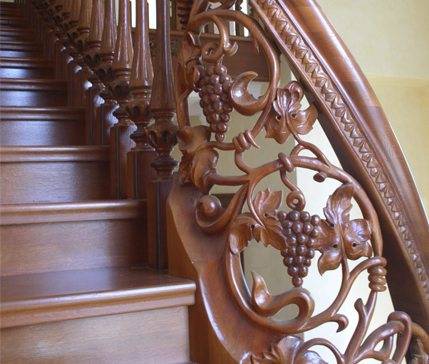
- Wooden handrails.
Oak handrails come in completely different shapes, from round to carved with metal inserts.
This element is selected depending on your wishes and preferences:
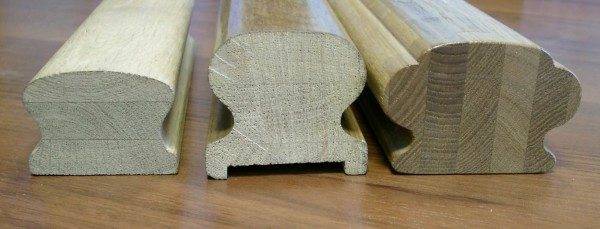
- Oval and round handrails are considered the most comfortable, as they fit well in the hand. Of course, the quality of workmanship affects the tactile sensations, but even a simple sanding and a layer of varnish already create favorable emotions.
- Rectangular handrails are not as attractive unless they are carved. It is easier to create a drawing on such products, up to individual wishes.
Note!
Railings can be both vertical and inclined, the second option requires the use of special fasteners.
At the same time, outwardly, they look unusual and are considered more dangerous for preschool children.
The handrails can be fixed to the wall, depending on if the staircase is installed in a narrow partition.
Wooden stringer or bowstring
These elements are the supporting elements of the staircase, they are massive one-piece products, usually their thickness is equal to or slightly greater than the thickness of the step. They are made of the required length, depending on the height of your house and the angle of inclination.
It should be understood that the longer the support, the sharper the angle of the stairs and the more useful area will be "eaten" by this structure.
For your information!
A march is a flight of stairs that connects two staircases or two levels, while resting directly on them.
There is a difference between pivots:
- Kosour - rectangular cutouts are made for the steps of the stairs, on which it is placed, the fixation occurs through the step. The depth of the cut can be either equal to the depth of the platform, or less by a few centimeters.
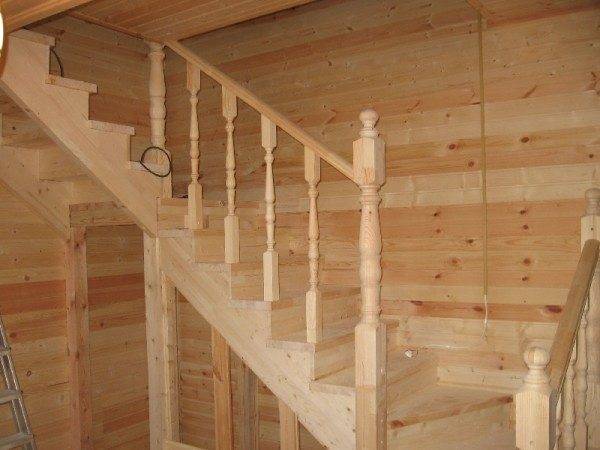
- Bowstring - grooves are cut in this support equal to the thickness of the step. The product is fixed from the end, the depth of the groove is usually equal to half the thickness of the bowstring.
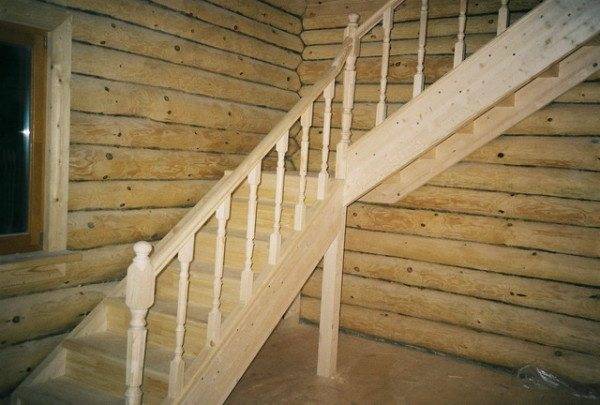
Each of the options has its own advantages and disadvantages, but the most important difference is visual, so you will have to independently determine for yourself which one suits you.
Additional elements of a wooden staircase
- Riser (riser) - is the vertical part of the step, which allows you to increase the strength of the tread (step). Not a required element, but desirable for a staircase located in the central part of the room.
- Boltz is not a wooden element (metal bolt), but is also an additional item that allows you to fix the steps to the wall.
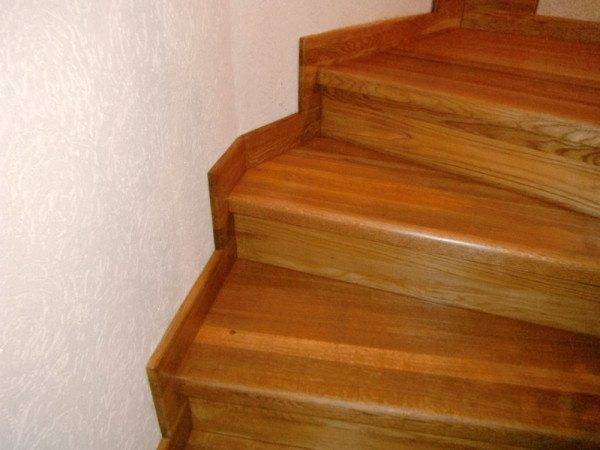
- The base of the ladder - this structure bears the load of the entire ladder and allows it to be in a stationary position. Not required in cases where the staircase has only one flight, that is, it connects, without turns, the first and second floors of the house.
- Support column - used only when a spiral staircase is installed.

Features of oak stairs
We want to remind you that comfortable conditions that must be created in the room are very important for natural wood. If the temperature and humidity changes are too noticeable, even the highest quality tree may suffer.
To avoid adverse effects, try to get humidifiers that keep the humidity at the same level. And, of course, take care of temperature jumps, even if they are, they are not so obvious.
Output
The above instruction allows even an inexperienced builder to understand what an oak staircase consists of. In fact, all the elements are also present on products made from other tree species, but you and I know how the oak stands out against the general background.
In the video presented in this article, you will find additional information on this topic.



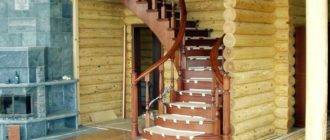
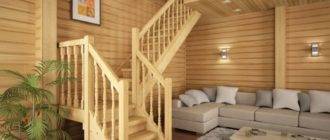
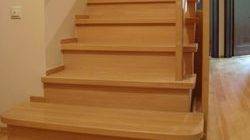

It is difficult to disagree here that it is oak that is best suited as a material from which a staircase should be made. As for me, this is just an ideal option. But I only doubt that this is the most affordable option. But everyone has their own capabilities, so you should take this into account. I personally would only make myself of oak, because such a staircase will last for centuries.